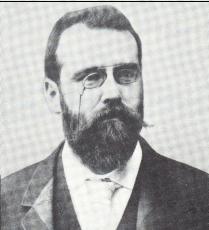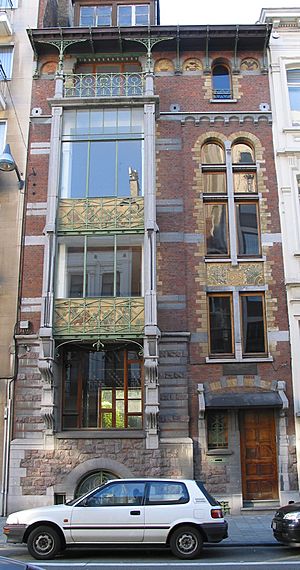Paul Hankar facts for kids
Quick facts for kids
Paul Hankar
|
|
|---|---|

Hankar c. 1890
|
|
| Born | 11 December 1859 |
| Died | 17 January 1901 (aged 41) Brussels, Province of Brabant, Belgium
|
| Nationality | Belgian |
| Occupation | Architect |
| Buildings |
|
| Projects |
|
Paul Hankar (born December 11, 1859 – died January 17, 1901) was a famous Belgian architect. He also designed furniture. He was a leader in creating the new and exciting Art Nouveau style.
Contents
Paul Hankar's Career and Style
Paul Hankar was born in Frameries, Belgium. His father was a stonemason, someone who works with stone. Paul studied at the Royal Academy of Fine Arts in Brussels. There, he met Victor Horta, who would also become a famous architect.
Both Hankar and Horta carefully studied how to work with forged iron. This is metal shaped by heating and hammering. They later used this skill in many of their buildings. Hankar first started his career by designing and sculpting monuments for graves.
From 1879 to 1904, he worked for a well-known architect named Henri Beyaert. Beyaert was a master of different styles, including eclectic architecture (mixing styles) and neoclassical architecture (inspired by ancient Greek and Roman buildings).
Through Beyaert, Hankar admired Eugène Viollet-le-Duc. This French architect believed in using new materials like iron and glass. He also liked to get ideas from older buildings. Hankar was the main designer for the Palacio de Chávarri in Bilbao, Spain, built in 1889.
Starting His Own Architecture Office
In 1893, Paul Hankar opened his own office in Brussels. He also started building his own house, the Hankar House. This house is located at 71, rue Defacqz/Defacqzstraat in Saint-Gilles.
The Hankar House and Victor Horta's Hôtel Tassel were built at the same time. They are seen as the first two houses designed in the Art Nouveau style. Art Nouveau was a new art movement that used flowing, natural shapes.
Hankar's house shows its structure clearly on the outside. The front part with the entrance is slightly different from the rest of the house. A three-story section sticks out, letting in lots of light. It also has a balcony.
Mural paintings by his friend Adolphe Crespin decorate the house. These paintings are under the windows and near the roof. The house mixes strong old-style elements with light, decorative Art Nouveau details. This creates a lively and interesting look.
Projects and Influence
In 1896, Hankar proposed a "City of Artists" for the town of Westende in Belgium. This was meant to be a place where artists could live and work together. The project was never built. However, it later inspired other artist communities, like the Darmstadt Artists' Colony in Germany.
For the 1897 World's Fair in Brussels, Hankar helped design the Congo section. This part of the fair was famous for fully using the Art Nouveau style. He also gave talks about "New Brussels," his idea for redesigning the city. This plan was also never built.
Later that year, he worked on the Colonial Exposition in Tervuren, near Brussels. He helped organize the work of many different artists and furniture makers.
Hankar designed a large stone bench in 1898–99. It was shown at the Exposition Universelle (1900) in Paris. The King of Belgium, Leopold II of Belgium, bought the bench. He gave it to a park in Ostend. The original bench was removed and destroyed in 1971. A new one, made from Hankar's original drawings, was carved and put in the same spot in 2003–04.
Teaching and Writing
During his career, Paul Hankar taught engineering at the School of Applied Arts in Schaerbeek from 1891 to 1897. He also taught architectural history at the University of Brussels from 1897 to 1901.
He was also an editor for L'Emulation magazine from 1894 to 1896. This magazine helped promote the new Art Nouveau style.
Paul Hankar passed away in January 1901 at the age of 41. Even though he died young, his unique style greatly influenced younger artists in Brussels. These included Paul Hamesse, Léon Sneyers, Antoine Pompe, and the modernist Victor Bourgeois.
Hankar and Horta: A Comparison
Paul Hankar and Victor Horta both finished their first Art Nouveau houses in the same year, 1893. Their styles had some similarities. Both architects moved away from old, traditional building styles. They also openly used new materials like glass and iron in their designs.
They both liked arches and curving lines in their work. This curving style was sometimes called à membrures. It was a key feature in their early buildings.
However, there was a big difference in their budgets. Hankar designed homes for his artist friends, who had less money. Horta, on the other hand, worked for very rich people. This meant Horta could use expensive materials and build much larger houses.
Horta's houses were famous for their amazing interiors. Hankar, however, focused more on the outside of his buildings. Hankar even thought Horta's work was too fancy, calling it "Louis XV," after a very decorative French king's style.
Selected Works by Paul Hankar
Buildings Designed by Hankar
- Mausoleum of Charles Rogier, Brussels (1870s).
- Palacio de Chávarri, Bilbao, Spain (1888–89). Hankar designed this while working for Henri Beyaert.
- Studio of Alfred Crick, Brussels (1891).
- Jan van Beers Monument, Antwerp (1891).
- Maison Hankar, Brussels (1893). This was his own home.
- Maisons Jaspar, Brussels (1894).
- Maisons Hanssens, Brussels (1894).
- Maison Zegers-Regnard, Brussels (1894–95).
- Chemiserie Niguet, Brussels (1896). This was a storefront.
- Maison and Pharmacy Peeters, Brussels (1896).
- Boulangerie Timmermans, Liège (1896, now gone). Its front was covered in murals.
- Hôtel Albert Ciamberlani, Brussels (1897).
- Sanatorium, Kraainem (1897).
- Hôtel Janssens, Brussels (1898).
- Hôtel Kleyer, Brussels (1898).
- Maison Aglave, Brussels (1898).
- Jean-François Willems Monument, Ghent (1899). Hankar designed the base for this monument.
- Monumental stone bench, Ostend (2003–04 replica). The original was made for the 1900 Paris World's Fair.
Furniture and Interiors by Hankar
- Stool (around 1893), now in the Design Museum, Ghent.
- Chair (1896), shown at the 1897 Brussels International Exposition.
- Mailbox (1897), at the Nelson-Atkins Museum of Art in Kansas City.
- Coffee table from Hôtel Renkin (1897).
- Dining table from Hôtel Ciamberlani (1897), now at the Musée d'Orsay in Paris.
- Sideboard from Hôtel Ciamberlani (1897).
- Card table from Hôtel Ciamberlani (1897).
- Side chair from Hôtel Ciamberlani (1897).
- Swivel chair (around 1897).
- Chair with woven leather back (around 1897).
- Mahogany dining table (around 1897).
- Furniture and interiors for the American Bar and Grill-Room (1897–98) at the Grand Hôtel de Bruxelles. This included folding screens and stools.
- Stool from Compagnie Générale des Céramiques d'Architecture (1898), at the Los Angeles County Museum of Art.
Images for kids
-
Palacio de Chávarri, Bilbao, Spain (1888–89)
-
Bas-relief panel on the facade of the Maison Aglave, Brussels (1898)
-
Stool, Los Angeles County Museum of Art, California (1898)
See also
 In Spanish: Paul Hankar para niños
In Spanish: Paul Hankar para niños
- Art Nouveau in Brussels












